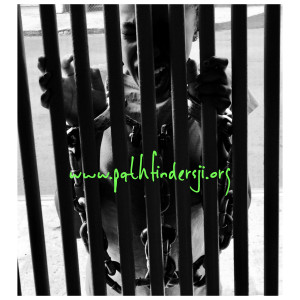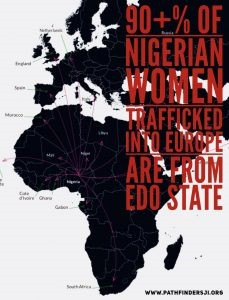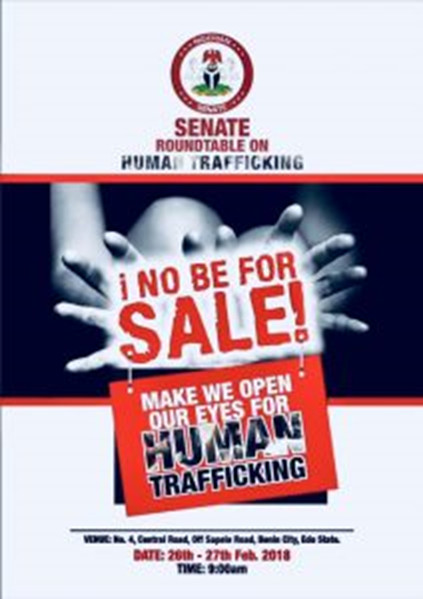

Human trafficking, a form of modern day slavery, involves the illegal trade of people for exploitation or commercial gain and is a $150 billion global industry. Two thirds of this figure ($99 billion) is generated from commercial sexual exploitation, while another $51 billion results from forced economic exploitation, including domestic work, agriculture and other economic activities. Supra. The average woman trafficked for forced sexual servitude/exploitation generates $100,000 in annual profits (anywhere from 100% to 1,000% return on investment) (Organization for Security and Co-operation in Europe (OSCE)). According to the United Nations, the smuggling route from East, North and West Africa to Europe is said to generate $150 million in annual profits ($35 billion globally).
New estimates released by the Global Slavery Index in July 2018 indicate that there are 40.3 million victims of modern slavery worldwide, 71% of whom are women and girls and 25% of which are children. (It is noteworthy that the UNODC’s January 7, 2019 Report now estimates the number of children in slavery at almost 1/3 of all global victims.)
99% of the 4.8 million victims of commercial sexual exploitation in 2016 were women and girls, with one in five being children (ILO, 2017). Women and girls represented 84% of the 15.4 million people in forced marriages, and 59% of those in private forced labour (8.7 Alliance 2017 Report). The Index maintains that modern day slavery is most prevalent in Africa (with 9.24 million slaves and an average vulnerability score of 62/100).
Human trafficking is a high profit, low risk business which allows traffickers to generally operate with impunity. Globally, in 2017, there were only a total of 17,880 prosecutions and 7,045 convictions. Of all the global victims, only 100,409 were identified. See 2018 U.S. State Department Trafficking In Persons Report. A dismal 1,733 prosecutions and 454 convictions were generated on the entire African continent (2018 U.S. State Department Trafficking in Persons Report).
Nigeria is a source, transit and destination country when it comes to human trafficking. Per the latest Global Slavery Index (2018) Report, Nigeria ranks 32/167 of the countries with the highest number of slaves – 1,386,000 – and its National Agency for the Prohibition of Trafficking in Persons (NAPTIP) reports that the average age of trafficked children in Nigeria, ranked a Tier 2 Watchlist country on the U.S. State Department’s Trafficking In Persons Report (2018), is 15. NAPTIP further contends that 75% of those who are trafficked within Nigeria are trafficked across states, while 23% are trafficked within states. Only 2% of those who are trafficked are trafficked outside the country, according to NAPTIP (2016). It is the third most common crime in Nigeria after drug trafficking and economic fraud (UNESCO, 2006). The general factors that increase vulnerability to trafficking in Nigeria include extreme poverty (now the world’s poverty capital), corruption, conflict, climate change/resulting migration and western consumerism.
The total number of human trafficking victims outside of Nigeria is largely unknown. However, it is undisputed that principally due to Nigeria’s population, Nigeria is routinely listed as one of the countries with the largest number of trafficking victims overseas (particularly in Europe), with victims identified in over 40 countries in 2017. The recent scourge of illegal migration has highlighted Nigeria’s challenges in this area, with one former Nigerian Permanent Representative to the United Nations (Mr. Martin Uhomoibhi) contending in June 2017 that in 2016 alone, 602,000 Nigerians endeavoured to migrate to Europe via the Sahara Desert. According to Mr. Uhomoibhi, 27,000 of these migrants died en route.
Also pretty alarming is his claim that of those who perished on the journey, 68% were Nigerian university graduates. Most estimates, however, place the total number of Nigerians arriving Europe in 2016 at about 40,000 and about 18,000 in 2017 (men, women and children).

In 2016, Nigerians accounted for about 21% of the total 181,000 migrants braving the Mediterranean to arrive into Italy. In 2017, that number decreased to 15.5% of total migrants arriving Italy (119,000) in light of the numerous efforts made by Italy and the European Union to stem the flow of migrants from Libya.
In 2018, however, Nigeria continued to feature among the top five countries of origin for irregular migrants illegally entering the European Union. More specifically, in the Sahel and Lake Chad region, it is the first country of origin of irregular migration towards Europe. The total number that embark on the journey from Nigeria is largely unknown, although according to the Nigeria Immigration Service, no fewer than 10,000 Nigerians died endeavoring to cross the Sahara Desert and the Mediterranean Sea (4,900) between January and May 2017. It is potentially feasible that at least triple the number of those that successfully arrive into Europe attempt the journey. As of December 2017, 36,512 migrants stranded in Niger and Libya indicated Nigeria as their country of origin (IOM).
The overwhelming majority of trafficking victims and illegal migrants make the treacherous journey from Edo State (particularly Benin) and Delta States to Kano, from where they are smuggled into Niger or Algeria before traversing 500 miles over the Sahara Desert into Libya. CNN contends that Edo State is the most trafficked through destination in Africa. In Libya, migrants are held in detention camps, generally for several weeks to months, before they are placed in unseaworthy dinghies or boats on the Mediterranean Sea. According to the United Nations’ International Organization for Migration (IOM), it has registered more than 400,000 total migrants in Libya, estimating that a total of anywhere between 700,000 and 1 million remain in what has become the primary gateway into Europe (91% of migrants attempt the journey into Europe from Libya). According to IOM, as of July 2018, over 60,000 Nigerians remain trapped in Libya, with 50% of them hailing from Edo State.
There are more readily available statistics on the numbers of women who are trafficked from Nigeria into Europe, particularly into Italy. According to IOM, approximately 11,000 women arrived via the Mediterranean Sea into Italy in 2016, again mostly from Edo. IOM estimates that 80% of these young women arriving from Nigeria – whose numbers have soared from 1,454 in 2014 to 11,009 in 2016 – will likely be forced into prostitution as sex trafficking victims. Supra. (According to Italian authorities, there are between 10,000 to 30,000 Nigerian women working in prostitution on the streets of Italy.) 90% of migrant women arriving into Italy from Libya arrive with bruises and other signs of violence. (In general, 83.5% of all Nigerians interviewed in 2017 reported to have suffered from physical violence of any kind during the journey, most often in Libya. A more recent December 2018 UN Report notes narratives by Nigerian migrants of unlawful killings, gang rape, prostitution, arbitrary detention, torture and inhumane treatment, unpaid wages, slavery, human trafficking, racism and xenophobia in Libya.) In 2017, a total of 18,000 Nigerian migrants were recorded to have arrived into Europe via the Mediterranean, 5,400 of which were women (UNHCR, 2018). It is noteworthy that in the last three years, IOM has recorded an almost 600% increase in the number of potential sex trafficking victims arriving in Italy via the Mediterranean.

Edo State is an internationally recognized sex trafficking hub, with built in infrastructures and networks which support the sale of human bodies. According to IOM, an astounding 94% of all Nigerian women trafficked to Europe for prostitution hail from Edo State, with Italy being the number one destination country. In fact, a 2003 United Nations Interregional Crime and Justice Research Institute Report concluded that, “virtually every Benin family has one member or the other involved in trafficking either as a victim, sponsor, madam or trafficker.” The souls and bodies of survivors are turned into commodities for financial gain while the survivors themselves are held in debt bondage, severely abused (often gang raped and physically assaulted), starved, tortured or infected with various sexually transmitted diseases before being deported back to Nigeria. Others who are victims of organ trafficking are murdered and never make it back to Nigeria.
In December 2016, the European Union (EU) and IOM developed the Joint Initiative for Migrant Protection and Re-integration in Africa to address the challenges of illegal migration. The Initiative is being implemented in 14 African countries, including Nigeria, where as of April 2019, over 12,000 irregular migrants have been voluntarily repatriated (mostly from Libya). Prior to the development of the aforementioned Joint Initiative, i.e., in March 2015, Nigeria entered into the Common Agenda for Migration and Mobility Agreement with the EU to address the following: (1) improving legal migration and mobility; (2) preventing and combatting irregular migration and human trafficking; (3) addressing the root causes and maximizing the development impact of migration; and (4) promoting international protection and support for internally displaced persons. It is currently negotiating a readmission agreement with the EU.
Although prostitution remains the largest category for Nigerian female trafficking victims, child labour is certainly another, with children engaged in domestic labour, forced begging, quarrying gravel and armed conflict. Women are also engaged in domestic servitude. According to NAPTIP’s April- September 2017 Report, most male victims are under age 11, with most female victims being over 18 years of age. Most rescued victims from the same report are from Edo and Delta States, with Edo leading.
Although prostitution remains the largest category for Nigerian female trafficking victims, child labour is certainly another, with children engaged in domestic labour, forced begging, quarrying gravel and armed conflict. Women are also engaged in domestic servitude. According to NAPTIP’s April- September 2017 Report, most male victims are under age 11, with most female victims being over 18 years of age. Most rescued victims from the same report are from Edo and Delta States, with Edo leading.
According to our research gleaned from hundreds of repatriating survivors of sex trafficking in Edo State, poverty remains the number one factor rendering women and girls vulnerable to sex trafficking.

However, additional factors such as parental pressure, eroded mindset/values, cultural acceptance of prostitution, limited education and economic opportunities combine to render young women and girls vulnerable to being trafficked. As a result, we at Pathfinders have successfully developed a trafficking profile based on 12 factors that establish our vulnerability criteria for potential female victims aged 15-25 years.
At Pathfinders, we believe that the fight against sex trafficking requires an interdisciplinary approach that utilizes a combined human rights, cognitive/behavior restructuring and an economic development methodology. As such, we are working to ensure that every young woman in Nigeria has an opportunity to live a life that is dignified and one that is graced with self determination; one where she is not robbed of agency. To advance our goal of structural transformation on the African continent, we are building a community of survivors who are becoming awakened to their potential and are not only poverty reduction driven, but are laser focused on wealth creation for themselves, their local communities and the continent. Many are returning to school, while others are small business owners; all are committed to changing their narratives from victim to survivor to Pathfinders advocate.
Our solution to Nigeria’s sex trafficking problem is Project Restore, a Project we are working with while they are painstakingly designing to holistically address the issue by providing customized interventions in local government areas, beginning in Edo State
Brought to you by:
